Case study of Martin
VerifiedAdded on 2022/11/18
|16
|5017
|320
AI Summary
This essay is about the case study of a patient named Martin Chen, who is 78 years old. Martin has complex healthcare needs such as Type 2 diabetes mellitus, hypertension, and vascular dementia. The essay discusses wound management, behavior management, hypertension management, and the importance of multidisciplinary teams in providing care for patients like Martin.
Contribute Materials
Your contribution can guide someone’s learning journey. Share your
documents today.
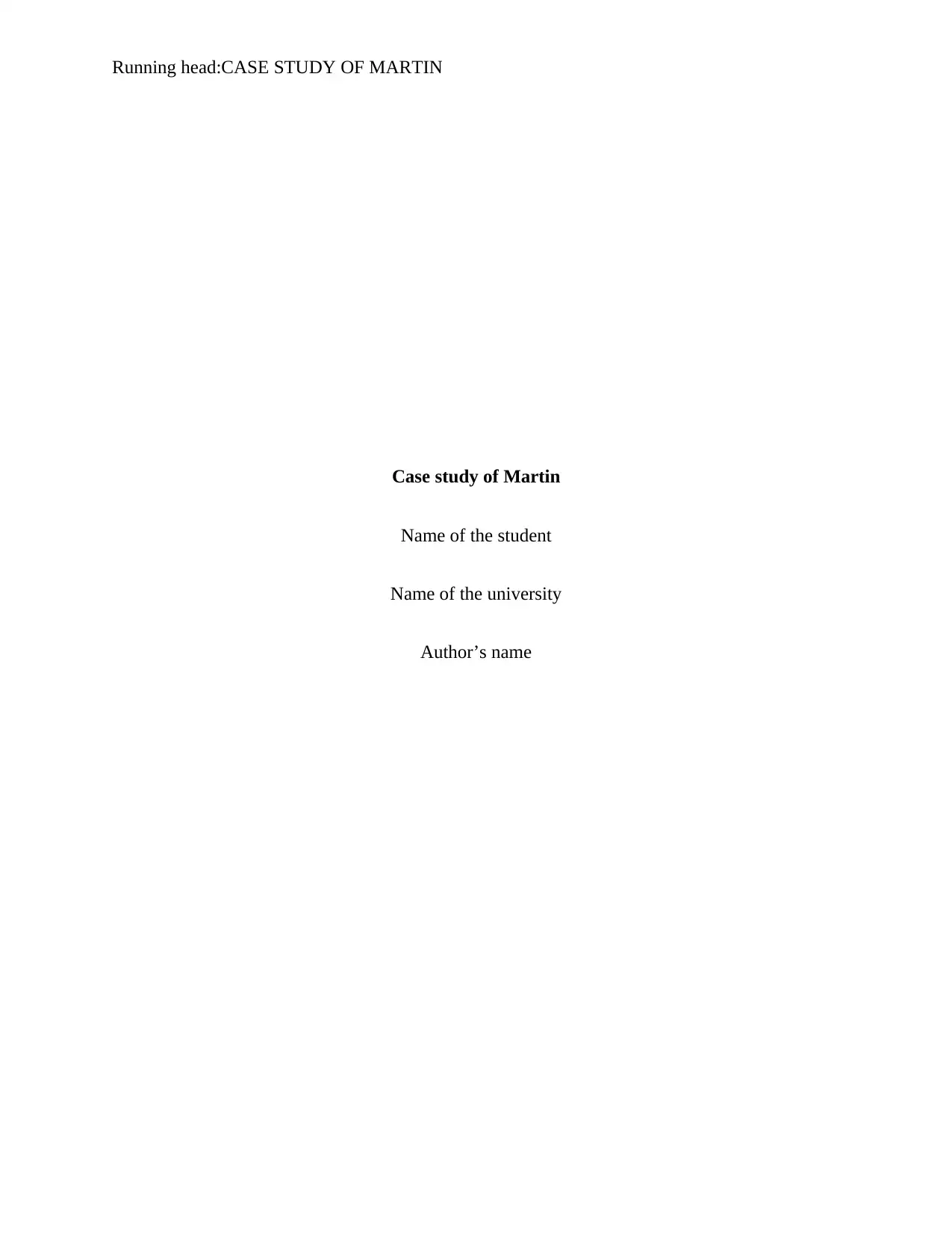
Running head:CASE STUDY OF MARTIN
Case study of Martin
Name of the student
Name of the university
Author’s name
Case study of Martin
Name of the student
Name of the university
Author’s name
Secure Best Marks with AI Grader
Need help grading? Try our AI Grader for instant feedback on your assignments.
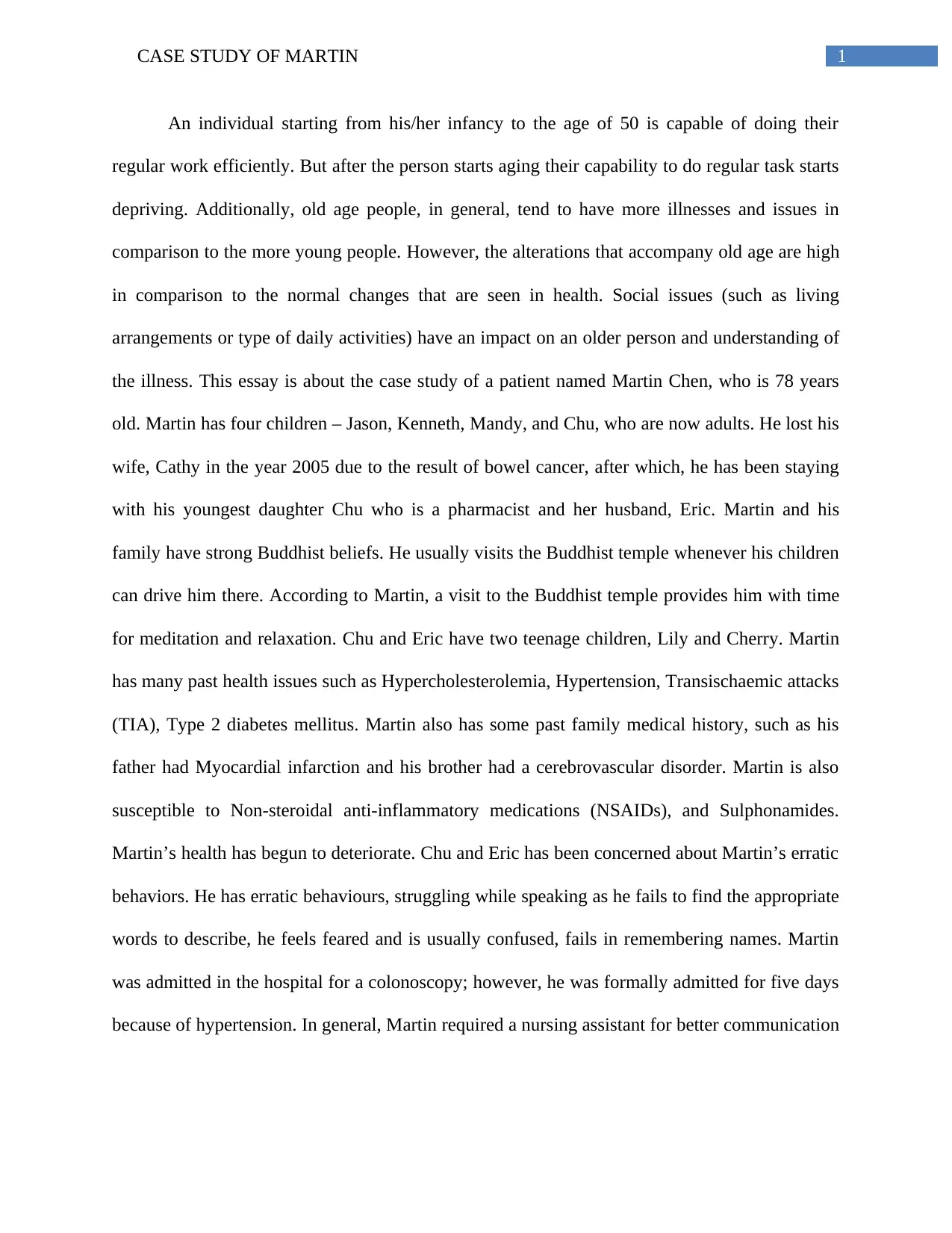
1CASE STUDY OF MARTIN
An individual starting from his/her infancy to the age of 50 is capable of doing their
regular work efficiently. But after the person starts aging their capability to do regular task starts
depriving. Additionally, old age people, in general, tend to have more illnesses and issues in
comparison to the more young people. However, the alterations that accompany old age are high
in comparison to the normal changes that are seen in health. Social issues (such as living
arrangements or type of daily activities) have an impact on an older person and understanding of
the illness. This essay is about the case study of a patient named Martin Chen, who is 78 years
old. Martin has four children – Jason, Kenneth, Mandy, and Chu, who are now adults. He lost his
wife, Cathy in the year 2005 due to the result of bowel cancer, after which, he has been staying
with his youngest daughter Chu who is a pharmacist and her husband, Eric. Martin and his
family have strong Buddhist beliefs. He usually visits the Buddhist temple whenever his children
can drive him there. According to Martin, a visit to the Buddhist temple provides him with time
for meditation and relaxation. Chu and Eric have two teenage children, Lily and Cherry. Martin
has many past health issues such as Hypercholesterolemia, Hypertension, Transischaemic attacks
(TIA), Type 2 diabetes mellitus. Martin also has some past family medical history, such as his
father had Myocardial infarction and his brother had a cerebrovascular disorder. Martin is also
susceptible to Non-steroidal anti-inflammatory medications (NSAIDs), and Sulphonamides.
Martin’s health has begun to deteriorate. Chu and Eric has been concerned about Martin’s erratic
behaviors. He has erratic behaviours, struggling while speaking as he fails to find the appropriate
words to describe, he feels feared and is usually confused, fails in remembering names. Martin
was admitted in the hospital for a colonoscopy; however, he was formally admitted for five days
because of hypertension. In general, Martin required a nursing assistant for better communication
An individual starting from his/her infancy to the age of 50 is capable of doing their
regular work efficiently. But after the person starts aging their capability to do regular task starts
depriving. Additionally, old age people, in general, tend to have more illnesses and issues in
comparison to the more young people. However, the alterations that accompany old age are high
in comparison to the normal changes that are seen in health. Social issues (such as living
arrangements or type of daily activities) have an impact on an older person and understanding of
the illness. This essay is about the case study of a patient named Martin Chen, who is 78 years
old. Martin has four children – Jason, Kenneth, Mandy, and Chu, who are now adults. He lost his
wife, Cathy in the year 2005 due to the result of bowel cancer, after which, he has been staying
with his youngest daughter Chu who is a pharmacist and her husband, Eric. Martin and his
family have strong Buddhist beliefs. He usually visits the Buddhist temple whenever his children
can drive him there. According to Martin, a visit to the Buddhist temple provides him with time
for meditation and relaxation. Chu and Eric have two teenage children, Lily and Cherry. Martin
has many past health issues such as Hypercholesterolemia, Hypertension, Transischaemic attacks
(TIA), Type 2 diabetes mellitus. Martin also has some past family medical history, such as his
father had Myocardial infarction and his brother had a cerebrovascular disorder. Martin is also
susceptible to Non-steroidal anti-inflammatory medications (NSAIDs), and Sulphonamides.
Martin’s health has begun to deteriorate. Chu and Eric has been concerned about Martin’s erratic
behaviors. He has erratic behaviours, struggling while speaking as he fails to find the appropriate
words to describe, he feels feared and is usually confused, fails in remembering names. Martin
was admitted in the hospital for a colonoscopy; however, he was formally admitted for five days
because of hypertension. In general, Martin required a nursing assistant for better communication
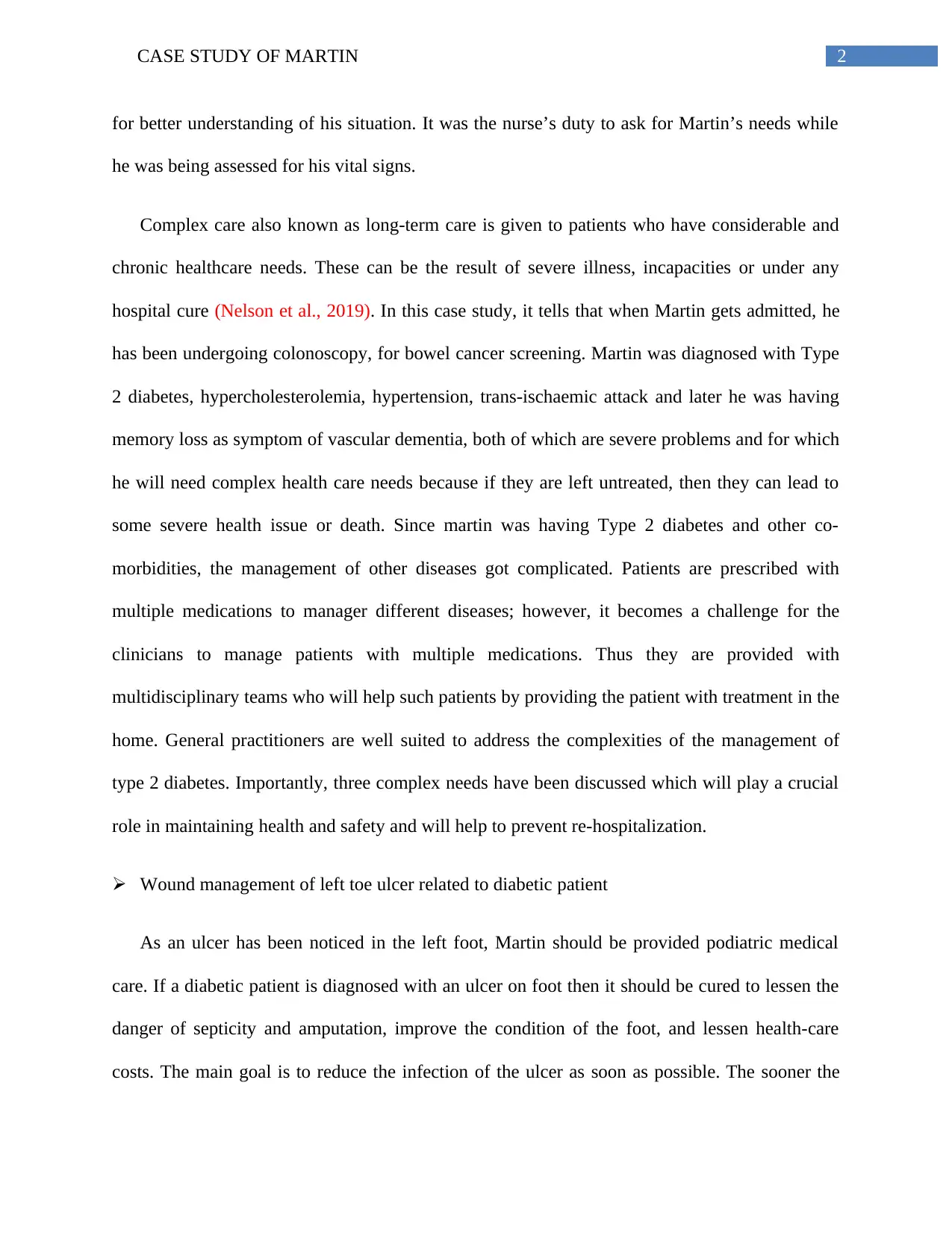
2CASE STUDY OF MARTIN
for better understanding of his situation. It was the nurse’s duty to ask for Martin’s needs while
he was being assessed for his vital signs.
Complex care also known as long-term care is given to patients who have considerable and
chronic healthcare needs. These can be the result of severe illness, incapacities or under any
hospital cure (Nelson et al., 2019). In this case study, it tells that when Martin gets admitted, he
has been undergoing colonoscopy, for bowel cancer screening. Martin was diagnosed with Type
2 diabetes, hypercholesterolemia, hypertension, trans-ischaemic attack and later he was having
memory loss as symptom of vascular dementia, both of which are severe problems and for which
he will need complex health care needs because if they are left untreated, then they can lead to
some severe health issue or death. Since martin was having Type 2 diabetes and other co-
morbidities, the management of other diseases got complicated. Patients are prescribed with
multiple medications to manager different diseases; however, it becomes a challenge for the
clinicians to manage patients with multiple medications. Thus they are provided with
multidisciplinary teams who will help such patients by providing the patient with treatment in the
home. General practitioners are well suited to address the complexities of the management of
type 2 diabetes. Importantly, three complex needs have been discussed which will play a crucial
role in maintaining health and safety and will help to prevent re-hospitalization.
Wound management of left toe ulcer related to diabetic patient
As an ulcer has been noticed in the left foot, Martin should be provided podiatric medical
care. If a diabetic patient is diagnosed with an ulcer on foot then it should be cured to lessen the
danger of septicity and amputation, improve the condition of the foot, and lessen health-care
costs. The main goal is to reduce the infection of the ulcer as soon as possible. The sooner the
for better understanding of his situation. It was the nurse’s duty to ask for Martin’s needs while
he was being assessed for his vital signs.
Complex care also known as long-term care is given to patients who have considerable and
chronic healthcare needs. These can be the result of severe illness, incapacities or under any
hospital cure (Nelson et al., 2019). In this case study, it tells that when Martin gets admitted, he
has been undergoing colonoscopy, for bowel cancer screening. Martin was diagnosed with Type
2 diabetes, hypercholesterolemia, hypertension, trans-ischaemic attack and later he was having
memory loss as symptom of vascular dementia, both of which are severe problems and for which
he will need complex health care needs because if they are left untreated, then they can lead to
some severe health issue or death. Since martin was having Type 2 diabetes and other co-
morbidities, the management of other diseases got complicated. Patients are prescribed with
multiple medications to manager different diseases; however, it becomes a challenge for the
clinicians to manage patients with multiple medications. Thus they are provided with
multidisciplinary teams who will help such patients by providing the patient with treatment in the
home. General practitioners are well suited to address the complexities of the management of
type 2 diabetes. Importantly, three complex needs have been discussed which will play a crucial
role in maintaining health and safety and will help to prevent re-hospitalization.
Wound management of left toe ulcer related to diabetic patient
As an ulcer has been noticed in the left foot, Martin should be provided podiatric medical
care. If a diabetic patient is diagnosed with an ulcer on foot then it should be cured to lessen the
danger of septicity and amputation, improve the condition of the foot, and lessen health-care
costs. The main goal is to reduce the infection of the ulcer as soon as possible. The sooner the
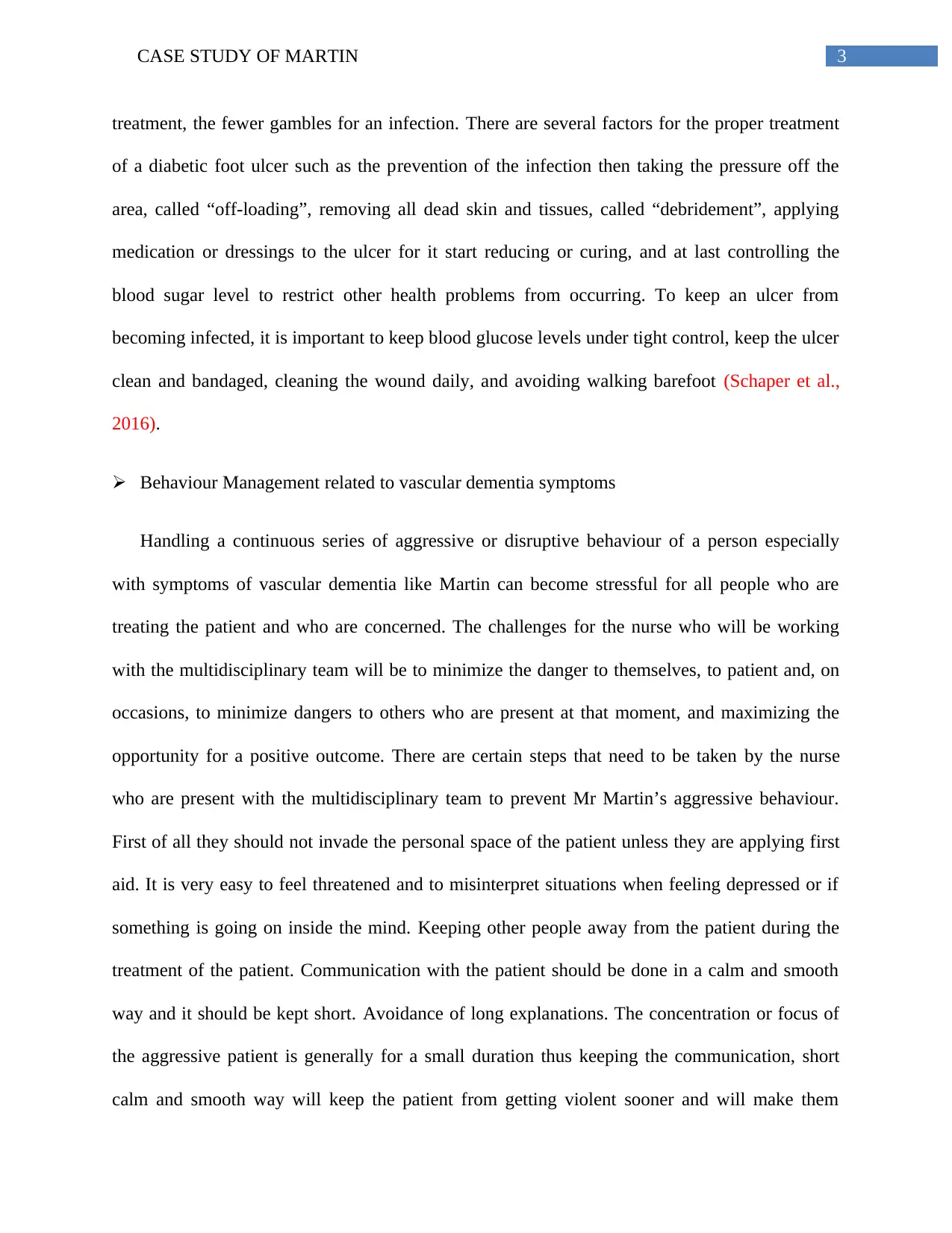
3CASE STUDY OF MARTIN
treatment, the fewer gambles for an infection. There are several factors for the proper treatment
of a diabetic foot ulcer such as the prevention of the infection then taking the pressure off the
area, called “off-loading”, removing all dead skin and tissues, called “debridement”, applying
medication or dressings to the ulcer for it start reducing or curing, and at last controlling the
blood sugar level to restrict other health problems from occurring. To keep an ulcer from
becoming infected, it is important to keep blood glucose levels under tight control, keep the ulcer
clean and bandaged, cleaning the wound daily, and avoiding walking barefoot (Schaper et al.,
2016).
Behaviour Management related to vascular dementia symptoms
Handling a continuous series of aggressive or disruptive behaviour of a person especially
with symptoms of vascular dementia like Martin can become stressful for all people who are
treating the patient and who are concerned. The challenges for the nurse who will be working
with the multidisciplinary team will be to minimize the danger to themselves, to patient and, on
occasions, to minimize dangers to others who are present at that moment, and maximizing the
opportunity for a positive outcome. There are certain steps that need to be taken by the nurse
who are present with the multidisciplinary team to prevent Mr Martin’s aggressive behaviour.
First of all they should not invade the personal space of the patient unless they are applying first
aid. It is very easy to feel threatened and to misinterpret situations when feeling depressed or if
something is going on inside the mind. Keeping other people away from the patient during the
treatment of the patient. Communication with the patient should be done in a calm and smooth
way and it should be kept short. Avoidance of long explanations. The concentration or focus of
the aggressive patient is generally for a small duration thus keeping the communication, short
calm and smooth way will keep the patient from getting violent sooner and will make them
treatment, the fewer gambles for an infection. There are several factors for the proper treatment
of a diabetic foot ulcer such as the prevention of the infection then taking the pressure off the
area, called “off-loading”, removing all dead skin and tissues, called “debridement”, applying
medication or dressings to the ulcer for it start reducing or curing, and at last controlling the
blood sugar level to restrict other health problems from occurring. To keep an ulcer from
becoming infected, it is important to keep blood glucose levels under tight control, keep the ulcer
clean and bandaged, cleaning the wound daily, and avoiding walking barefoot (Schaper et al.,
2016).
Behaviour Management related to vascular dementia symptoms
Handling a continuous series of aggressive or disruptive behaviour of a person especially
with symptoms of vascular dementia like Martin can become stressful for all people who are
treating the patient and who are concerned. The challenges for the nurse who will be working
with the multidisciplinary team will be to minimize the danger to themselves, to patient and, on
occasions, to minimize dangers to others who are present at that moment, and maximizing the
opportunity for a positive outcome. There are certain steps that need to be taken by the nurse
who are present with the multidisciplinary team to prevent Mr Martin’s aggressive behaviour.
First of all they should not invade the personal space of the patient unless they are applying first
aid. It is very easy to feel threatened and to misinterpret situations when feeling depressed or if
something is going on inside the mind. Keeping other people away from the patient during the
treatment of the patient. Communication with the patient should be done in a calm and smooth
way and it should be kept short. Avoidance of long explanations. The concentration or focus of
the aggressive patient is generally for a small duration thus keeping the communication, short
calm and smooth way will keep the patient from getting violent sooner and will make them
Secure Best Marks with AI Grader
Need help grading? Try our AI Grader for instant feedback on your assignments.
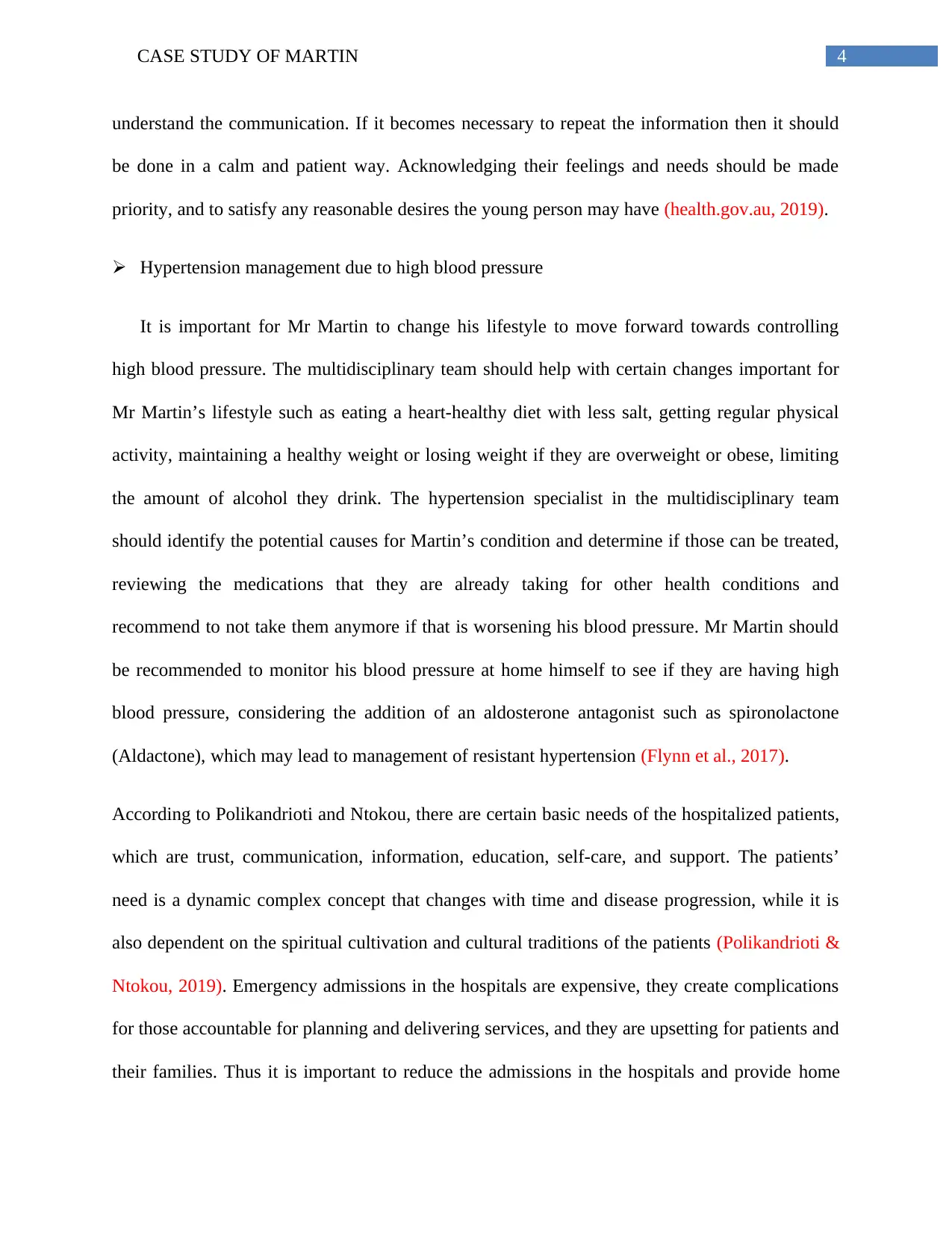
4CASE STUDY OF MARTIN
understand the communication. If it becomes necessary to repeat the information then it should
be done in a calm and patient way. Acknowledging their feelings and needs should be made
priority, and to satisfy any reasonable desires the young person may have (health.gov.au, 2019).
Hypertension management due to high blood pressure
It is important for Mr Martin to change his lifestyle to move forward towards controlling
high blood pressure. The multidisciplinary team should help with certain changes important for
Mr Martin’s lifestyle such as eating a heart-healthy diet with less salt, getting regular physical
activity, maintaining a healthy weight or losing weight if they are overweight or obese, limiting
the amount of alcohol they drink. The hypertension specialist in the multidisciplinary team
should identify the potential causes for Martin’s condition and determine if those can be treated,
reviewing the medications that they are already taking for other health conditions and
recommend to not take them anymore if that is worsening his blood pressure. Mr Martin should
be recommended to monitor his blood pressure at home himself to see if they are having high
blood pressure, considering the addition of an aldosterone antagonist such as spironolactone
(Aldactone), which may lead to management of resistant hypertension (Flynn et al., 2017).
According to Polikandrioti and Ntokou, there are certain basic needs of the hospitalized patients,
which are trust, communication, information, education, self-care, and support. The patients’
need is a dynamic complex concept that changes with time and disease progression, while it is
also dependent on the spiritual cultivation and cultural traditions of the patients (Polikandrioti &
Ntokou, 2019). Emergency admissions in the hospitals are expensive, they create complications
for those accountable for planning and delivering services, and they are upsetting for patients and
their families. Thus it is important to reduce the admissions in the hospitals and provide home
understand the communication. If it becomes necessary to repeat the information then it should
be done in a calm and patient way. Acknowledging their feelings and needs should be made
priority, and to satisfy any reasonable desires the young person may have (health.gov.au, 2019).
Hypertension management due to high blood pressure
It is important for Mr Martin to change his lifestyle to move forward towards controlling
high blood pressure. The multidisciplinary team should help with certain changes important for
Mr Martin’s lifestyle such as eating a heart-healthy diet with less salt, getting regular physical
activity, maintaining a healthy weight or losing weight if they are overweight or obese, limiting
the amount of alcohol they drink. The hypertension specialist in the multidisciplinary team
should identify the potential causes for Martin’s condition and determine if those can be treated,
reviewing the medications that they are already taking for other health conditions and
recommend to not take them anymore if that is worsening his blood pressure. Mr Martin should
be recommended to monitor his blood pressure at home himself to see if they are having high
blood pressure, considering the addition of an aldosterone antagonist such as spironolactone
(Aldactone), which may lead to management of resistant hypertension (Flynn et al., 2017).
According to Polikandrioti and Ntokou, there are certain basic needs of the hospitalized patients,
which are trust, communication, information, education, self-care, and support. The patients’
need is a dynamic complex concept that changes with time and disease progression, while it is
also dependent on the spiritual cultivation and cultural traditions of the patients (Polikandrioti &
Ntokou, 2019). Emergency admissions in the hospitals are expensive, they create complications
for those accountable for planning and delivering services, and they are upsetting for patients and
their families. Thus it is important to reduce the admissions in the hospitals and provide home
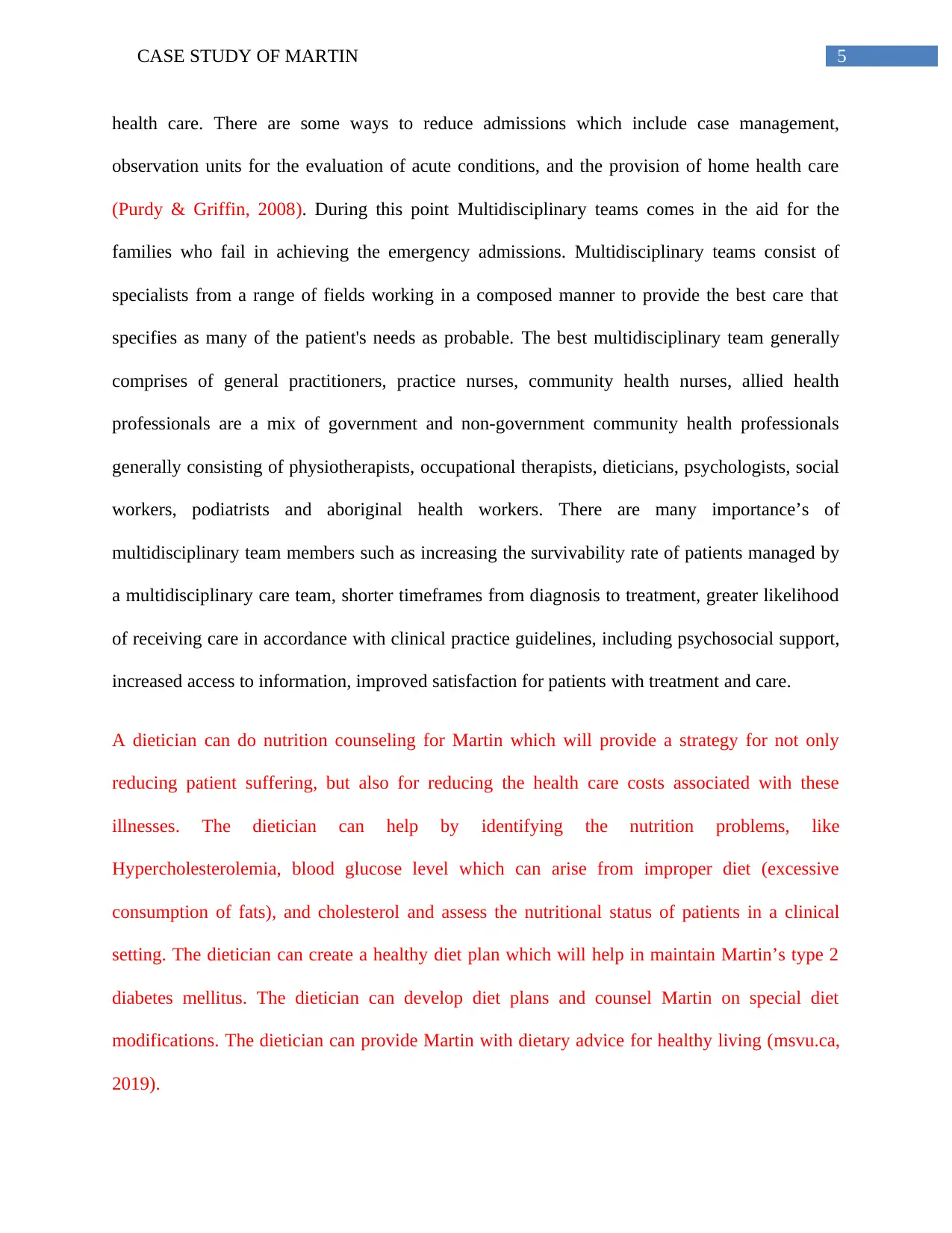
5CASE STUDY OF MARTIN
health care. There are some ways to reduce admissions which include case management,
observation units for the evaluation of acute conditions, and the provision of home health care
(Purdy & Griffin, 2008). During this point Multidisciplinary teams comes in the aid for the
families who fail in achieving the emergency admissions. Multidisciplinary teams consist of
specialists from a range of fields working in a composed manner to provide the best care that
specifies as many of the patient's needs as probable. The best multidisciplinary team generally
comprises of general practitioners, practice nurses, community health nurses, allied health
professionals are a mix of government and non-government community health professionals
generally consisting of physiotherapists, occupational therapists, dieticians, psychologists, social
workers, podiatrists and aboriginal health workers. There are many importance’s of
multidisciplinary team members such as increasing the survivability rate of patients managed by
a multidisciplinary care team, shorter timeframes from diagnosis to treatment, greater likelihood
of receiving care in accordance with clinical practice guidelines, including psychosocial support,
increased access to information, improved satisfaction for patients with treatment and care.
A dietician can do nutrition counseling for Martin which will provide a strategy for not only
reducing patient suffering, but also for reducing the health care costs associated with these
illnesses. The dietician can help by identifying the nutrition problems, like
Hypercholesterolemia, blood glucose level which can arise from improper diet (excessive
consumption of fats), and cholesterol and assess the nutritional status of patients in a clinical
setting. The dietician can create a healthy diet plan which will help in maintain Martin’s type 2
diabetes mellitus. The dietician can develop diet plans and counsel Martin on special diet
modifications. The dietician can provide Martin with dietary advice for healthy living (msvu.ca,
2019).
health care. There are some ways to reduce admissions which include case management,
observation units for the evaluation of acute conditions, and the provision of home health care
(Purdy & Griffin, 2008). During this point Multidisciplinary teams comes in the aid for the
families who fail in achieving the emergency admissions. Multidisciplinary teams consist of
specialists from a range of fields working in a composed manner to provide the best care that
specifies as many of the patient's needs as probable. The best multidisciplinary team generally
comprises of general practitioners, practice nurses, community health nurses, allied health
professionals are a mix of government and non-government community health professionals
generally consisting of physiotherapists, occupational therapists, dieticians, psychologists, social
workers, podiatrists and aboriginal health workers. There are many importance’s of
multidisciplinary team members such as increasing the survivability rate of patients managed by
a multidisciplinary care team, shorter timeframes from diagnosis to treatment, greater likelihood
of receiving care in accordance with clinical practice guidelines, including psychosocial support,
increased access to information, improved satisfaction for patients with treatment and care.
A dietician can do nutrition counseling for Martin which will provide a strategy for not only
reducing patient suffering, but also for reducing the health care costs associated with these
illnesses. The dietician can help by identifying the nutrition problems, like
Hypercholesterolemia, blood glucose level which can arise from improper diet (excessive
consumption of fats), and cholesterol and assess the nutritional status of patients in a clinical
setting. The dietician can create a healthy diet plan which will help in maintain Martin’s type 2
diabetes mellitus. The dietician can develop diet plans and counsel Martin on special diet
modifications. The dietician can provide Martin with dietary advice for healthy living (msvu.ca,
2019).
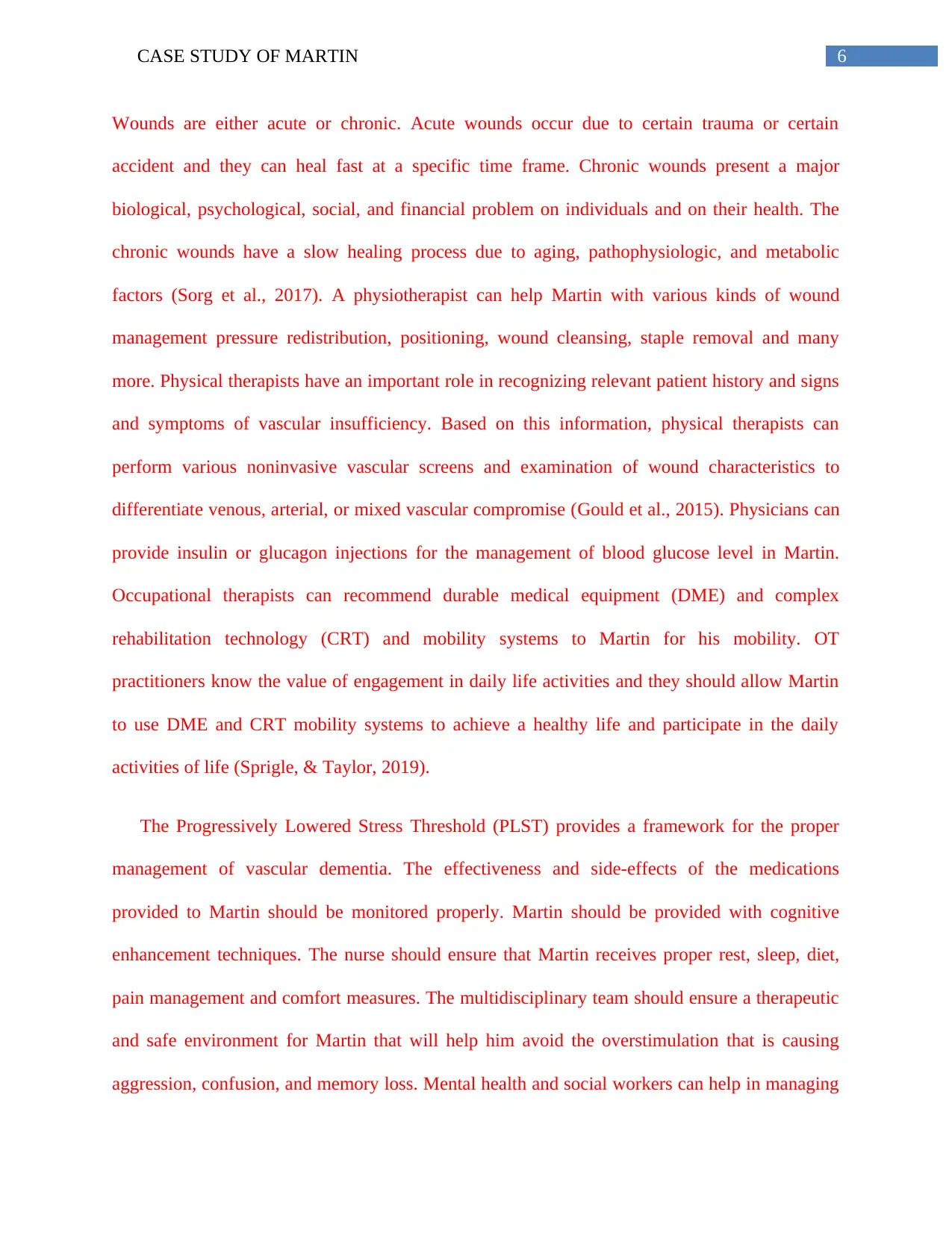
6CASE STUDY OF MARTIN
Wounds are either acute or chronic. Acute wounds occur due to certain trauma or certain
accident and they can heal fast at a specific time frame. Chronic wounds present a major
biological, psychological, social, and financial problem on individuals and on their health. The
chronic wounds have a slow healing process due to aging, pathophysiologic, and metabolic
factors (Sorg et al., 2017). A physiotherapist can help Martin with various kinds of wound
management pressure redistribution, positioning, wound cleansing, staple removal and many
more. Physical therapists have an important role in recognizing relevant patient history and signs
and symptoms of vascular insufficiency. Based on this information, physical therapists can
perform various noninvasive vascular screens and examination of wound characteristics to
differentiate venous, arterial, or mixed vascular compromise (Gould et al., 2015). Physicians can
provide insulin or glucagon injections for the management of blood glucose level in Martin.
Occupational therapists can recommend durable medical equipment (DME) and complex
rehabilitation technology (CRT) and mobility systems to Martin for his mobility. OT
practitioners know the value of engagement in daily life activities and they should allow Martin
to use DME and CRT mobility systems to achieve a healthy life and participate in the daily
activities of life (Sprigle, & Taylor, 2019).
The Progressively Lowered Stress Threshold (PLST) provides a framework for the proper
management of vascular dementia. The effectiveness and side-effects of the medications
provided to Martin should be monitored properly. Martin should be provided with cognitive
enhancement techniques. The nurse should ensure that Martin receives proper rest, sleep, diet,
pain management and comfort measures. The multidisciplinary team should ensure a therapeutic
and safe environment for Martin that will help him avoid the overstimulation that is causing
aggression, confusion, and memory loss. Mental health and social workers can help in managing
Wounds are either acute or chronic. Acute wounds occur due to certain trauma or certain
accident and they can heal fast at a specific time frame. Chronic wounds present a major
biological, psychological, social, and financial problem on individuals and on their health. The
chronic wounds have a slow healing process due to aging, pathophysiologic, and metabolic
factors (Sorg et al., 2017). A physiotherapist can help Martin with various kinds of wound
management pressure redistribution, positioning, wound cleansing, staple removal and many
more. Physical therapists have an important role in recognizing relevant patient history and signs
and symptoms of vascular insufficiency. Based on this information, physical therapists can
perform various noninvasive vascular screens and examination of wound characteristics to
differentiate venous, arterial, or mixed vascular compromise (Gould et al., 2015). Physicians can
provide insulin or glucagon injections for the management of blood glucose level in Martin.
Occupational therapists can recommend durable medical equipment (DME) and complex
rehabilitation technology (CRT) and mobility systems to Martin for his mobility. OT
practitioners know the value of engagement in daily life activities and they should allow Martin
to use DME and CRT mobility systems to achieve a healthy life and participate in the daily
activities of life (Sprigle, & Taylor, 2019).
The Progressively Lowered Stress Threshold (PLST) provides a framework for the proper
management of vascular dementia. The effectiveness and side-effects of the medications
provided to Martin should be monitored properly. Martin should be provided with cognitive
enhancement techniques. The nurse should ensure that Martin receives proper rest, sleep, diet,
pain management and comfort measures. The multidisciplinary team should ensure a therapeutic
and safe environment for Martin that will help him avoid the overstimulation that is causing
aggression, confusion, and memory loss. Mental health and social workers can help in managing
Paraphrase This Document
Need a fresh take? Get an instant paraphrase of this document with our AI Paraphraser
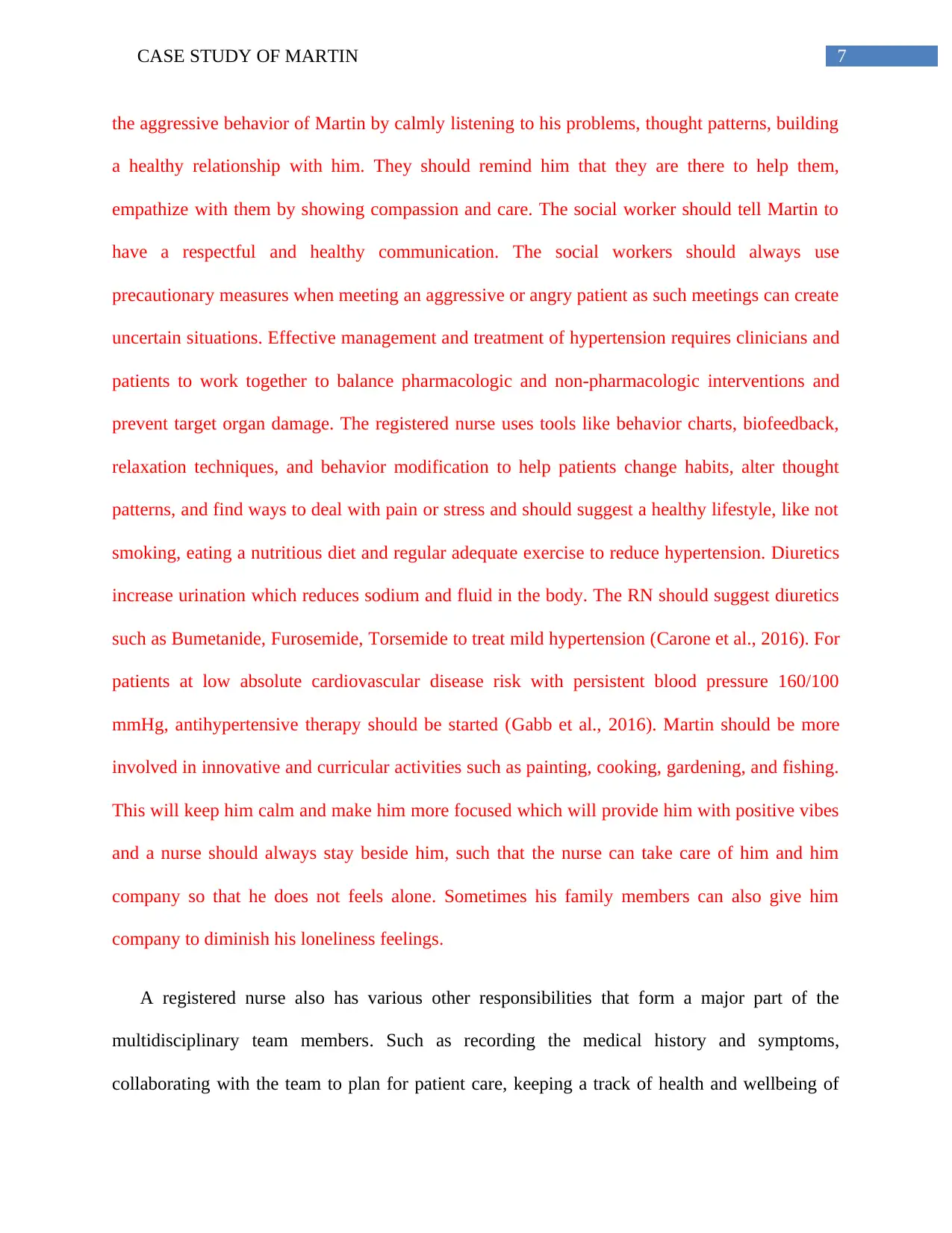
7CASE STUDY OF MARTIN
the aggressive behavior of Martin by calmly listening to his problems, thought patterns, building
a healthy relationship with him. They should remind him that they are there to help them,
empathize with them by showing compassion and care. The social worker should tell Martin to
have a respectful and healthy communication. The social workers should always use
precautionary measures when meeting an aggressive or angry patient as such meetings can create
uncertain situations. Effective management and treatment of hypertension requires clinicians and
patients to work together to balance pharmacologic and non-pharmacologic interventions and
prevent target organ damage. The registered nurse uses tools like behavior charts, biofeedback,
relaxation techniques, and behavior modification to help patients change habits, alter thought
patterns, and find ways to deal with pain or stress and should suggest a healthy lifestyle, like not
smoking, eating a nutritious diet and regular adequate exercise to reduce hypertension. Diuretics
increase urination which reduces sodium and fluid in the body. The RN should suggest diuretics
such as Bumetanide, Furosemide, Torsemide to treat mild hypertension (Carone et al., 2016). For
patients at low absolute cardiovascular disease risk with persistent blood pressure 160/100
mmHg, antihypertensive therapy should be started (Gabb et al., 2016). Martin should be more
involved in innovative and curricular activities such as painting, cooking, gardening, and fishing.
This will keep him calm and make him more focused which will provide him with positive vibes
and a nurse should always stay beside him, such that the nurse can take care of him and him
company so that he does not feels alone. Sometimes his family members can also give him
company to diminish his loneliness feelings.
A registered nurse also has various other responsibilities that form a major part of the
multidisciplinary team members. Such as recording the medical history and symptoms,
collaborating with the team to plan for patient care, keeping a track of health and wellbeing of
the aggressive behavior of Martin by calmly listening to his problems, thought patterns, building
a healthy relationship with him. They should remind him that they are there to help them,
empathize with them by showing compassion and care. The social worker should tell Martin to
have a respectful and healthy communication. The social workers should always use
precautionary measures when meeting an aggressive or angry patient as such meetings can create
uncertain situations. Effective management and treatment of hypertension requires clinicians and
patients to work together to balance pharmacologic and non-pharmacologic interventions and
prevent target organ damage. The registered nurse uses tools like behavior charts, biofeedback,
relaxation techniques, and behavior modification to help patients change habits, alter thought
patterns, and find ways to deal with pain or stress and should suggest a healthy lifestyle, like not
smoking, eating a nutritious diet and regular adequate exercise to reduce hypertension. Diuretics
increase urination which reduces sodium and fluid in the body. The RN should suggest diuretics
such as Bumetanide, Furosemide, Torsemide to treat mild hypertension (Carone et al., 2016). For
patients at low absolute cardiovascular disease risk with persistent blood pressure 160/100
mmHg, antihypertensive therapy should be started (Gabb et al., 2016). Martin should be more
involved in innovative and curricular activities such as painting, cooking, gardening, and fishing.
This will keep him calm and make him more focused which will provide him with positive vibes
and a nurse should always stay beside him, such that the nurse can take care of him and him
company so that he does not feels alone. Sometimes his family members can also give him
company to diminish his loneliness feelings.
A registered nurse also has various other responsibilities that form a major part of the
multidisciplinary team members. Such as recording the medical history and symptoms,
collaborating with the team to plan for patient care, keeping a track of health and wellbeing of
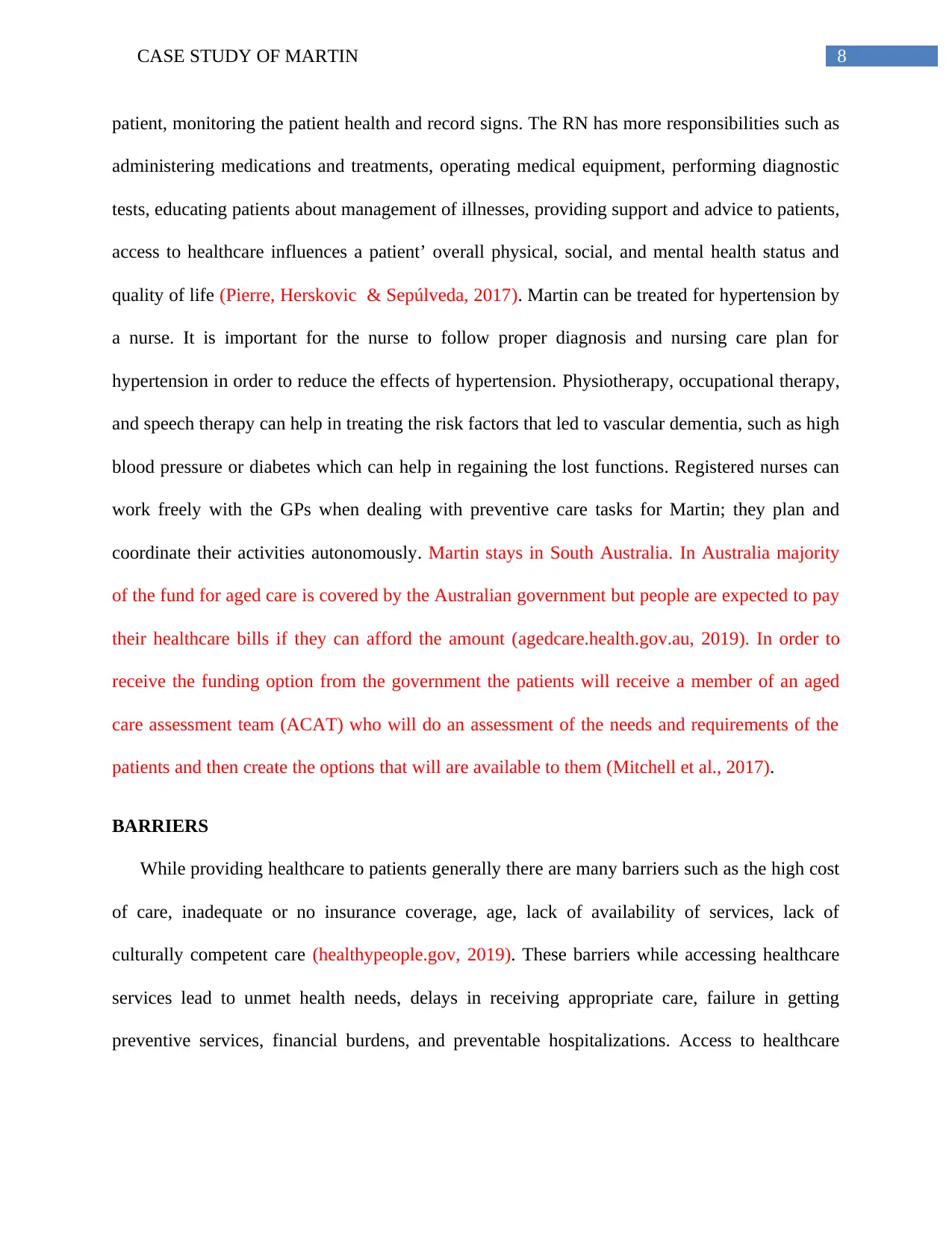
8CASE STUDY OF MARTIN
patient, monitoring the patient health and record signs. The RN has more responsibilities such as
administering medications and treatments, operating medical equipment, performing diagnostic
tests, educating patients about management of illnesses, providing support and advice to patients,
access to healthcare influences a patient’ overall physical, social, and mental health status and
quality of life (Pierre, Herskovic & Sepúlveda, 2017). Martin can be treated for hypertension by
a nurse. It is important for the nurse to follow proper diagnosis and nursing care plan for
hypertension in order to reduce the effects of hypertension. Physiotherapy, occupational therapy,
and speech therapy can help in treating the risk factors that led to vascular dementia, such as high
blood pressure or diabetes which can help in regaining the lost functions. Registered nurses can
work freely with the GPs when dealing with preventive care tasks for Martin; they plan and
coordinate their activities autonomously. Martin stays in South Australia. In Australia majority
of the fund for aged care is covered by the Australian government but people are expected to pay
their healthcare bills if they can afford the amount (agedcare.health.gov.au, 2019). In order to
receive the funding option from the government the patients will receive a member of an aged
care assessment team (ACAT) who will do an assessment of the needs and requirements of the
patients and then create the options that will are available to them (Mitchell et al., 2017).
BARRIERS
While providing healthcare to patients generally there are many barriers such as the high cost
of care, inadequate or no insurance coverage, age, lack of availability of services, lack of
culturally competent care (healthypeople.gov, 2019). These barriers while accessing healthcare
services lead to unmet health needs, delays in receiving appropriate care, failure in getting
preventive services, financial burdens, and preventable hospitalizations. Access to healthcare
patient, monitoring the patient health and record signs. The RN has more responsibilities such as
administering medications and treatments, operating medical equipment, performing diagnostic
tests, educating patients about management of illnesses, providing support and advice to patients,
access to healthcare influences a patient’ overall physical, social, and mental health status and
quality of life (Pierre, Herskovic & Sepúlveda, 2017). Martin can be treated for hypertension by
a nurse. It is important for the nurse to follow proper diagnosis and nursing care plan for
hypertension in order to reduce the effects of hypertension. Physiotherapy, occupational therapy,
and speech therapy can help in treating the risk factors that led to vascular dementia, such as high
blood pressure or diabetes which can help in regaining the lost functions. Registered nurses can
work freely with the GPs when dealing with preventive care tasks for Martin; they plan and
coordinate their activities autonomously. Martin stays in South Australia. In Australia majority
of the fund for aged care is covered by the Australian government but people are expected to pay
their healthcare bills if they can afford the amount (agedcare.health.gov.au, 2019). In order to
receive the funding option from the government the patients will receive a member of an aged
care assessment team (ACAT) who will do an assessment of the needs and requirements of the
patients and then create the options that will are available to them (Mitchell et al., 2017).
BARRIERS
While providing healthcare to patients generally there are many barriers such as the high cost
of care, inadequate or no insurance coverage, age, lack of availability of services, lack of
culturally competent care (healthypeople.gov, 2019). These barriers while accessing healthcare
services lead to unmet health needs, delays in receiving appropriate care, failure in getting
preventive services, financial burdens, and preventable hospitalizations. Access to healthcare
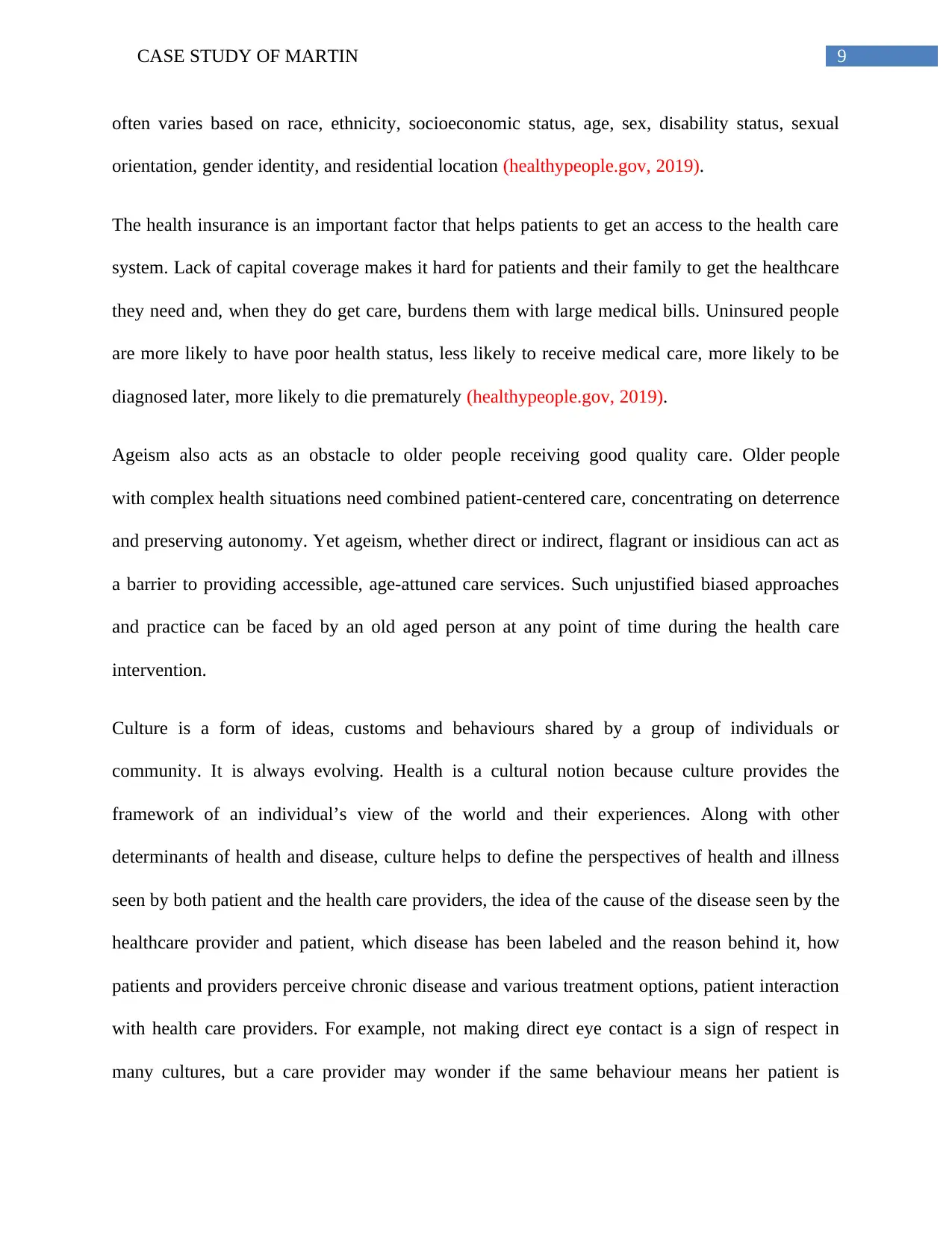
9CASE STUDY OF MARTIN
often varies based on race, ethnicity, socioeconomic status, age, sex, disability status, sexual
orientation, gender identity, and residential location (healthypeople.gov, 2019).
The health insurance is an important factor that helps patients to get an access to the health care
system. Lack of capital coverage makes it hard for patients and their family to get the healthcare
they need and, when they do get care, burdens them with large medical bills. Uninsured people
are more likely to have poor health status, less likely to receive medical care, more likely to be
diagnosed later, more likely to die prematurely (healthypeople.gov, 2019).
Ageism also acts as an obstacle to older people receiving good quality care. Older people
with complex health situations need combined patient-centered care, concentrating on deterrence
and preserving autonomy. Yet ageism, whether direct or indirect, flagrant or insidious can act as
a barrier to providing accessible, age-attuned care services. Such unjustified biased approaches
and practice can be faced by an old aged person at any point of time during the health care
intervention.
Culture is a form of ideas, customs and behaviours shared by a group of individuals or
community. It is always evolving. Health is a cultural notion because culture provides the
framework of an individual’s view of the world and their experiences. Along with other
determinants of health and disease, culture helps to define the perspectives of health and illness
seen by both patient and the health care providers, the idea of the cause of the disease seen by the
healthcare provider and patient, which disease has been labeled and the reason behind it, how
patients and providers perceive chronic disease and various treatment options, patient interaction
with health care providers. For example, not making direct eye contact is a sign of respect in
many cultures, but a care provider may wonder if the same behaviour means her patient is
often varies based on race, ethnicity, socioeconomic status, age, sex, disability status, sexual
orientation, gender identity, and residential location (healthypeople.gov, 2019).
The health insurance is an important factor that helps patients to get an access to the health care
system. Lack of capital coverage makes it hard for patients and their family to get the healthcare
they need and, when they do get care, burdens them with large medical bills. Uninsured people
are more likely to have poor health status, less likely to receive medical care, more likely to be
diagnosed later, more likely to die prematurely (healthypeople.gov, 2019).
Ageism also acts as an obstacle to older people receiving good quality care. Older people
with complex health situations need combined patient-centered care, concentrating on deterrence
and preserving autonomy. Yet ageism, whether direct or indirect, flagrant or insidious can act as
a barrier to providing accessible, age-attuned care services. Such unjustified biased approaches
and practice can be faced by an old aged person at any point of time during the health care
intervention.
Culture is a form of ideas, customs and behaviours shared by a group of individuals or
community. It is always evolving. Health is a cultural notion because culture provides the
framework of an individual’s view of the world and their experiences. Along with other
determinants of health and disease, culture helps to define the perspectives of health and illness
seen by both patient and the health care providers, the idea of the cause of the disease seen by the
healthcare provider and patient, which disease has been labeled and the reason behind it, how
patients and providers perceive chronic disease and various treatment options, patient interaction
with health care providers. For example, not making direct eye contact is a sign of respect in
many cultures, but a care provider may wonder if the same behaviour means her patient is
Secure Best Marks with AI Grader
Need help grading? Try our AI Grader for instant feedback on your assignments.
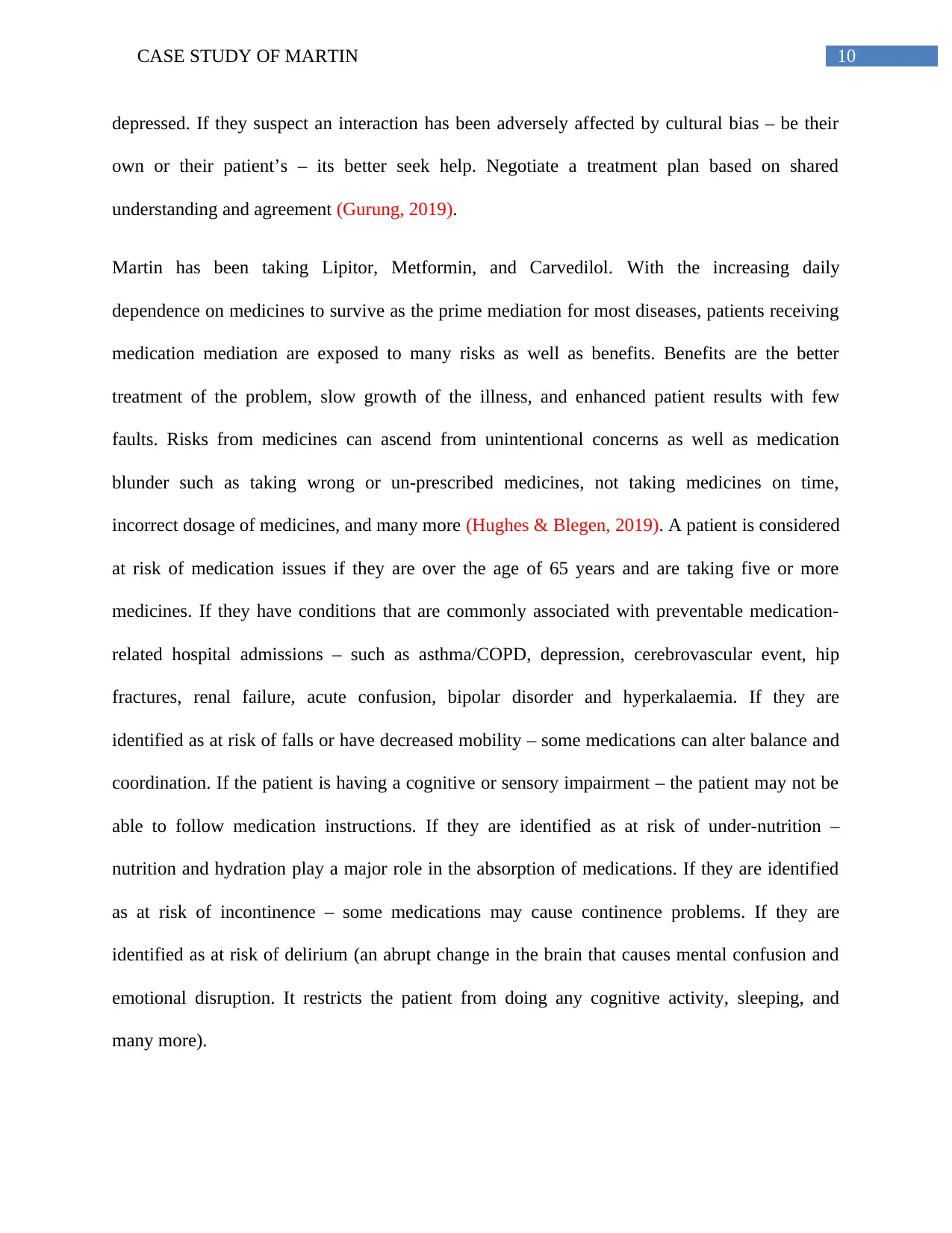
10CASE STUDY OF MARTIN
depressed. If they suspect an interaction has been adversely affected by cultural bias – be their
own or their patient’s – its better seek help. Negotiate a treatment plan based on shared
understanding and agreement (Gurung, 2019).
Martin has been taking Lipitor, Metformin, and Carvedilol. With the increasing daily
dependence on medicines to survive as the prime mediation for most diseases, patients receiving
medication mediation are exposed to many risks as well as benefits. Benefits are the better
treatment of the problem, slow growth of the illness, and enhanced patient results with few
faults. Risks from medicines can ascend from unintentional concerns as well as medication
blunder such as taking wrong or un-prescribed medicines, not taking medicines on time,
incorrect dosage of medicines, and many more (Hughes & Blegen, 2019). A patient is considered
at risk of medication issues if they are over the age of 65 years and are taking five or more
medicines. If they have conditions that are commonly associated with preventable medication-
related hospital admissions – such as asthma/COPD, depression, cerebrovascular event, hip
fractures, renal failure, acute confusion, bipolar disorder and hyperkalaemia. If they are
identified as at risk of falls or have decreased mobility – some medications can alter balance and
coordination. If the patient is having a cognitive or sensory impairment – the patient may not be
able to follow medication instructions. If they are identified as at risk of under-nutrition –
nutrition and hydration play a major role in the absorption of medications. If they are identified
as at risk of incontinence – some medications may cause continence problems. If they are
identified as at risk of delirium (an abrupt change in the brain that causes mental confusion and
emotional disruption. It restricts the patient from doing any cognitive activity, sleeping, and
many more).
depressed. If they suspect an interaction has been adversely affected by cultural bias – be their
own or their patient’s – its better seek help. Negotiate a treatment plan based on shared
understanding and agreement (Gurung, 2019).
Martin has been taking Lipitor, Metformin, and Carvedilol. With the increasing daily
dependence on medicines to survive as the prime mediation for most diseases, patients receiving
medication mediation are exposed to many risks as well as benefits. Benefits are the better
treatment of the problem, slow growth of the illness, and enhanced patient results with few
faults. Risks from medicines can ascend from unintentional concerns as well as medication
blunder such as taking wrong or un-prescribed medicines, not taking medicines on time,
incorrect dosage of medicines, and many more (Hughes & Blegen, 2019). A patient is considered
at risk of medication issues if they are over the age of 65 years and are taking five or more
medicines. If they have conditions that are commonly associated with preventable medication-
related hospital admissions – such as asthma/COPD, depression, cerebrovascular event, hip
fractures, renal failure, acute confusion, bipolar disorder and hyperkalaemia. If they are
identified as at risk of falls or have decreased mobility – some medications can alter balance and
coordination. If the patient is having a cognitive or sensory impairment – the patient may not be
able to follow medication instructions. If they are identified as at risk of under-nutrition –
nutrition and hydration play a major role in the absorption of medications. If they are identified
as at risk of incontinence – some medications may cause continence problems. If they are
identified as at risk of delirium (an abrupt change in the brain that causes mental confusion and
emotional disruption. It restricts the patient from doing any cognitive activity, sleeping, and
many more).
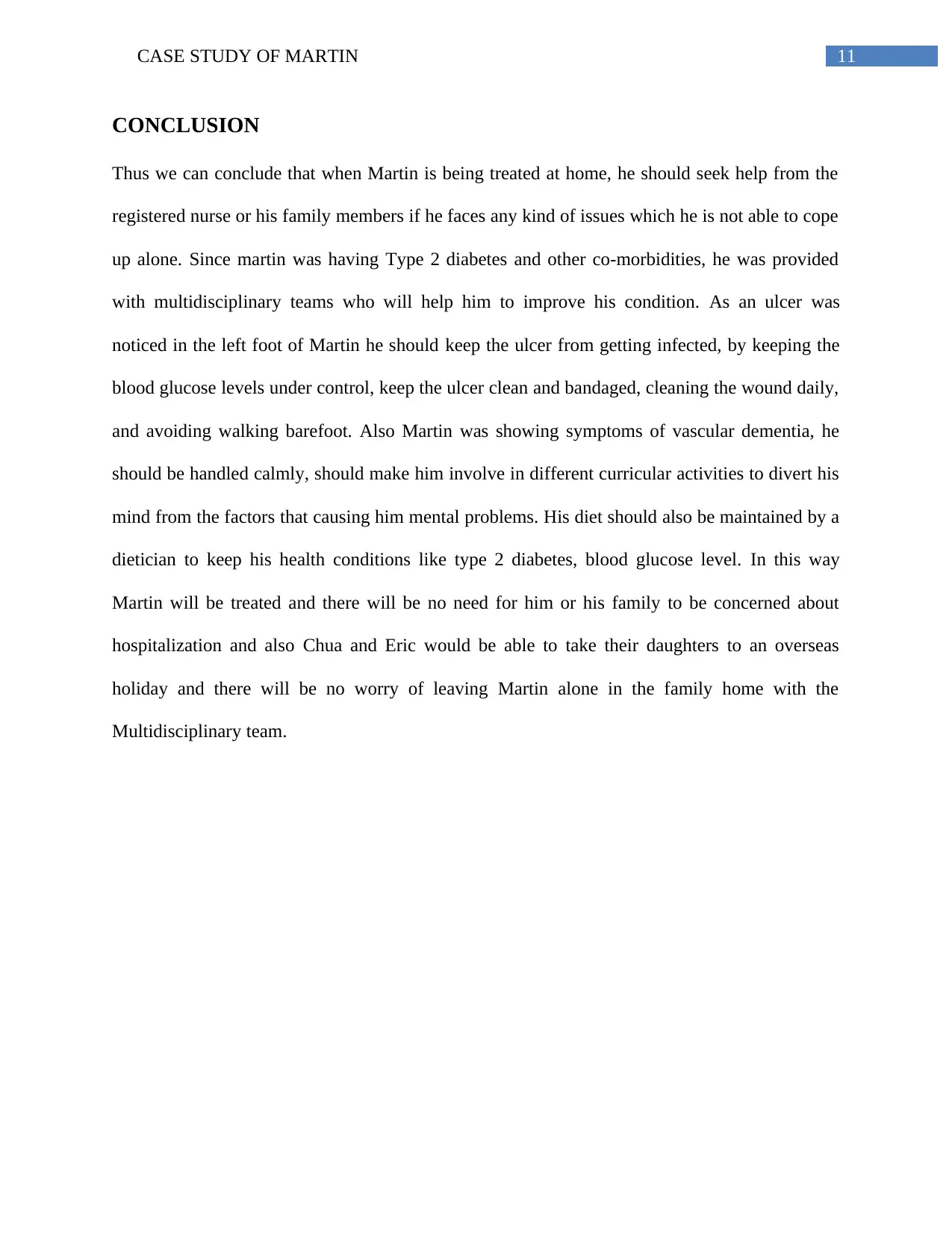
11CASE STUDY OF MARTIN
CONCLUSION
Thus we can conclude that when Martin is being treated at home, he should seek help from the
registered nurse or his family members if he faces any kind of issues which he is not able to cope
up alone. Since martin was having Type 2 diabetes and other co-morbidities, he was provided
with multidisciplinary teams who will help him to improve his condition. As an ulcer was
noticed in the left foot of Martin he should keep the ulcer from getting infected, by keeping the
blood glucose levels under control, keep the ulcer clean and bandaged, cleaning the wound daily,
and avoiding walking barefoot. Also Martin was showing symptoms of vascular dementia, he
should be handled calmly, should make him involve in different curricular activities to divert his
mind from the factors that causing him mental problems. His diet should also be maintained by a
dietician to keep his health conditions like type 2 diabetes, blood glucose level. In this way
Martin will be treated and there will be no need for him or his family to be concerned about
hospitalization and also Chua and Eric would be able to take their daughters to an overseas
holiday and there will be no worry of leaving Martin alone in the family home with the
Multidisciplinary team.
CONCLUSION
Thus we can conclude that when Martin is being treated at home, he should seek help from the
registered nurse or his family members if he faces any kind of issues which he is not able to cope
up alone. Since martin was having Type 2 diabetes and other co-morbidities, he was provided
with multidisciplinary teams who will help him to improve his condition. As an ulcer was
noticed in the left foot of Martin he should keep the ulcer from getting infected, by keeping the
blood glucose levels under control, keep the ulcer clean and bandaged, cleaning the wound daily,
and avoiding walking barefoot. Also Martin was showing symptoms of vascular dementia, he
should be handled calmly, should make him involve in different curricular activities to divert his
mind from the factors that causing him mental problems. His diet should also be maintained by a
dietician to keep his health conditions like type 2 diabetes, blood glucose level. In this way
Martin will be treated and there will be no need for him or his family to be concerned about
hospitalization and also Chua and Eric would be able to take their daughters to an overseas
holiday and there will be no worry of leaving Martin alone in the family home with the
Multidisciplinary team.
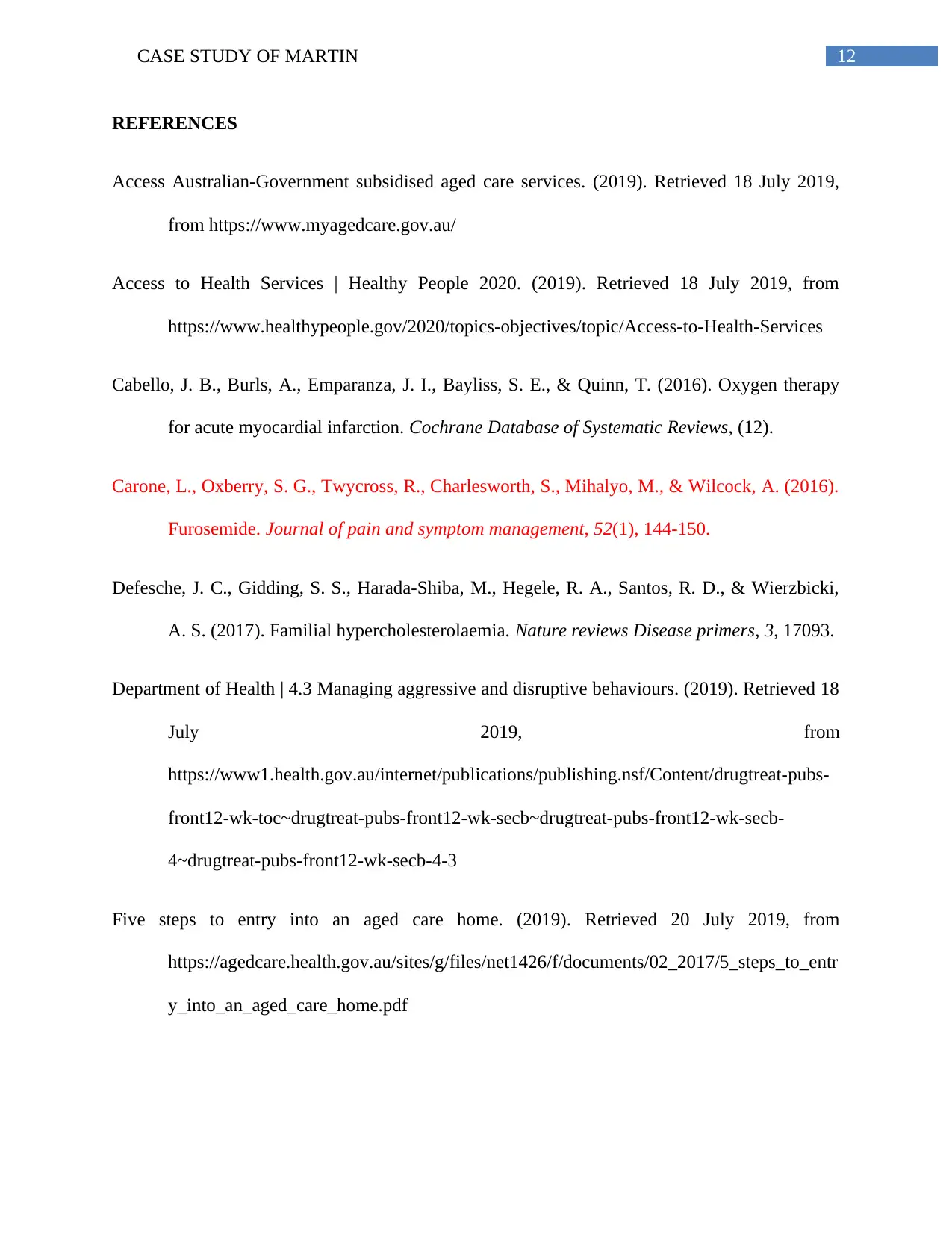
12CASE STUDY OF MARTIN
REFERENCES
Access Australian-Government subsidised aged care services. (2019). Retrieved 18 July 2019,
from https://www.myagedcare.gov.au/
Access to Health Services | Healthy People 2020. (2019). Retrieved 18 July 2019, from
https://www.healthypeople.gov/2020/topics-objectives/topic/Access-to-Health-Services
Cabello, J. B., Burls, A., Emparanza, J. I., Bayliss, S. E., & Quinn, T. (2016). Oxygen therapy
for acute myocardial infarction. Cochrane Database of Systematic Reviews, (12).
Carone, L., Oxberry, S. G., Twycross, R., Charlesworth, S., Mihalyo, M., & Wilcock, A. (2016).
Furosemide. Journal of pain and symptom management, 52(1), 144-150.
Defesche, J. C., Gidding, S. S., Harada-Shiba, M., Hegele, R. A., Santos, R. D., & Wierzbicki,
A. S. (2017). Familial hypercholesterolaemia. Nature reviews Disease primers, 3, 17093.
Department of Health | 4.3 Managing aggressive and disruptive behaviours. (2019). Retrieved 18
July 2019, from
https://www1.health.gov.au/internet/publications/publishing.nsf/Content/drugtreat-pubs-
front12-wk-toc~drugtreat-pubs-front12-wk-secb~drugtreat-pubs-front12-wk-secb-
4~drugtreat-pubs-front12-wk-secb-4-3
Five steps to entry into an aged care home. (2019). Retrieved 20 July 2019, from
https://agedcare.health.gov.au/sites/g/files/net1426/f/documents/02_2017/5_steps_to_entr
y_into_an_aged_care_home.pdf
REFERENCES
Access Australian-Government subsidised aged care services. (2019). Retrieved 18 July 2019,
from https://www.myagedcare.gov.au/
Access to Health Services | Healthy People 2020. (2019). Retrieved 18 July 2019, from
https://www.healthypeople.gov/2020/topics-objectives/topic/Access-to-Health-Services
Cabello, J. B., Burls, A., Emparanza, J. I., Bayliss, S. E., & Quinn, T. (2016). Oxygen therapy
for acute myocardial infarction. Cochrane Database of Systematic Reviews, (12).
Carone, L., Oxberry, S. G., Twycross, R., Charlesworth, S., Mihalyo, M., & Wilcock, A. (2016).
Furosemide. Journal of pain and symptom management, 52(1), 144-150.
Defesche, J. C., Gidding, S. S., Harada-Shiba, M., Hegele, R. A., Santos, R. D., & Wierzbicki,
A. S. (2017). Familial hypercholesterolaemia. Nature reviews Disease primers, 3, 17093.
Department of Health | 4.3 Managing aggressive and disruptive behaviours. (2019). Retrieved 18
July 2019, from
https://www1.health.gov.au/internet/publications/publishing.nsf/Content/drugtreat-pubs-
front12-wk-toc~drugtreat-pubs-front12-wk-secb~drugtreat-pubs-front12-wk-secb-
4~drugtreat-pubs-front12-wk-secb-4-3
Five steps to entry into an aged care home. (2019). Retrieved 20 July 2019, from
https://agedcare.health.gov.au/sites/g/files/net1426/f/documents/02_2017/5_steps_to_entr
y_into_an_aged_care_home.pdf
Paraphrase This Document
Need a fresh take? Get an instant paraphrase of this document with our AI Paraphraser
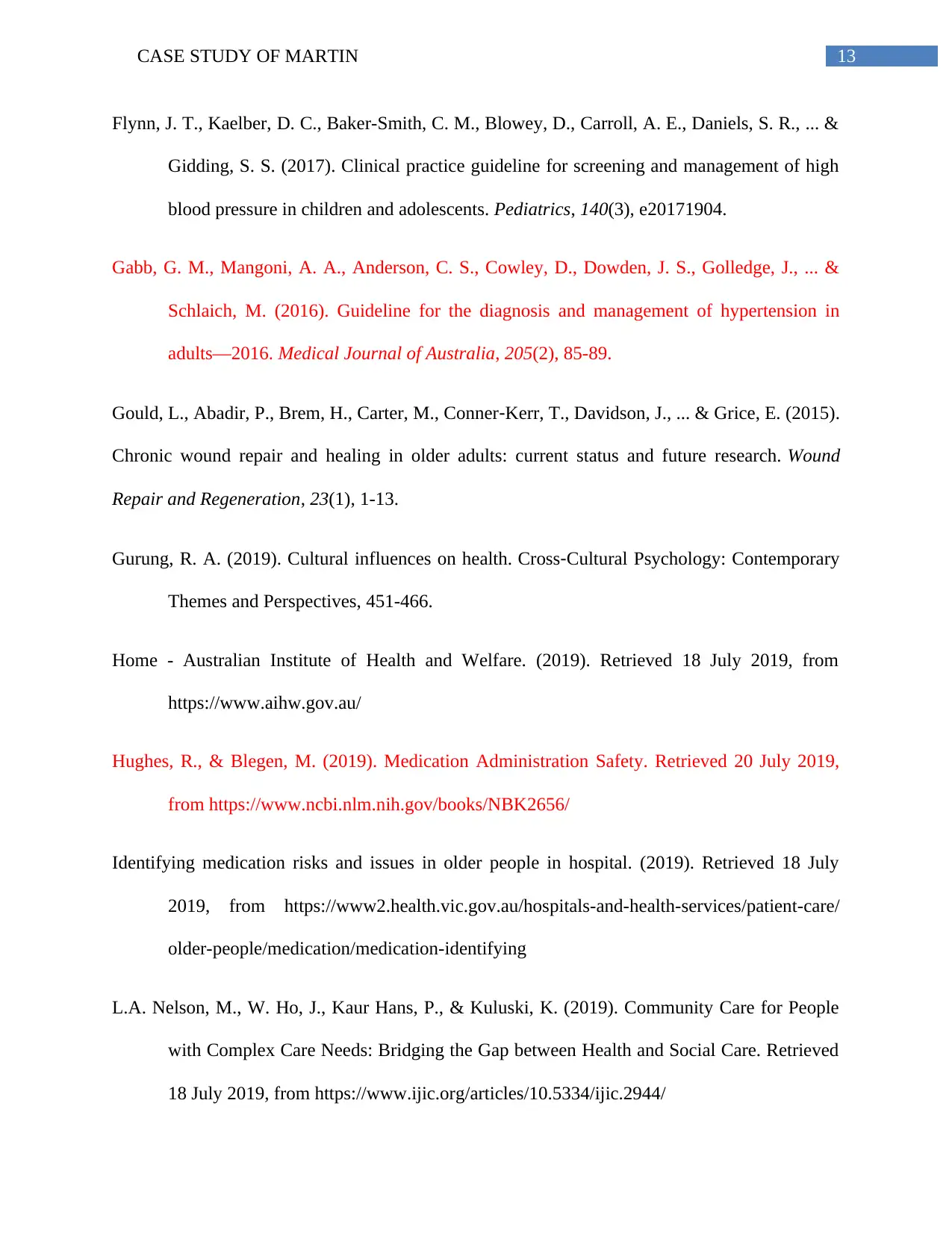
13CASE STUDY OF MARTIN
Flynn, J. T., Kaelber, D. C., Baker-Smith, C. M., Blowey, D., Carroll, A. E., Daniels, S. R., ... &
Gidding, S. S. (2017). Clinical practice guideline for screening and management of high
blood pressure in children and adolescents. Pediatrics, 140(3), e20171904.
Gabb, G. M., Mangoni, A. A., Anderson, C. S., Cowley, D., Dowden, J. S., Golledge, J., ... &
Schlaich, M. (2016). Guideline for the diagnosis and management of hypertension in
adults—2016. Medical Journal of Australia, 205(2), 85-89.
Gould, L., Abadir, P., Brem, H., Carter, M., Conner‐Kerr, T., Davidson, J., ... & Grice, E. (2015).
Chronic wound repair and healing in older adults: current status and future research. Wound
Repair and Regeneration, 23(1), 1-13.
Gurung, R. A. (2019). Cultural influences on health. Cross‐Cultural Psychology: Contemporary
Themes and Perspectives, 451-466.
Home - Australian Institute of Health and Welfare. (2019). Retrieved 18 July 2019, from
https://www.aihw.gov.au/
Hughes, R., & Blegen, M. (2019). Medication Administration Safety. Retrieved 20 July 2019,
from https://www.ncbi.nlm.nih.gov/books/NBK2656/
Identifying medication risks and issues in older people in hospital. (2019). Retrieved 18 July
2019, from https://www2.health.vic.gov.au/hospitals-and-health-services/patient-care/
older-people/medication/medication-identifying
L.A. Nelson, M., W. Ho, J., Kaur Hans, P., & Kuluski, K. (2019). Community Care for People
with Complex Care Needs: Bridging the Gap between Health and Social Care. Retrieved
18 July 2019, from https://www.ijic.org/articles/10.5334/ijic.2944/
Flynn, J. T., Kaelber, D. C., Baker-Smith, C. M., Blowey, D., Carroll, A. E., Daniels, S. R., ... &
Gidding, S. S. (2017). Clinical practice guideline for screening and management of high
blood pressure in children and adolescents. Pediatrics, 140(3), e20171904.
Gabb, G. M., Mangoni, A. A., Anderson, C. S., Cowley, D., Dowden, J. S., Golledge, J., ... &
Schlaich, M. (2016). Guideline for the diagnosis and management of hypertension in
adults—2016. Medical Journal of Australia, 205(2), 85-89.
Gould, L., Abadir, P., Brem, H., Carter, M., Conner‐Kerr, T., Davidson, J., ... & Grice, E. (2015).
Chronic wound repair and healing in older adults: current status and future research. Wound
Repair and Regeneration, 23(1), 1-13.
Gurung, R. A. (2019). Cultural influences on health. Cross‐Cultural Psychology: Contemporary
Themes and Perspectives, 451-466.
Home - Australian Institute of Health and Welfare. (2019). Retrieved 18 July 2019, from
https://www.aihw.gov.au/
Hughes, R., & Blegen, M. (2019). Medication Administration Safety. Retrieved 20 July 2019,
from https://www.ncbi.nlm.nih.gov/books/NBK2656/
Identifying medication risks and issues in older people in hospital. (2019). Retrieved 18 July
2019, from https://www2.health.vic.gov.au/hospitals-and-health-services/patient-care/
older-people/medication/medication-identifying
L.A. Nelson, M., W. Ho, J., Kaur Hans, P., & Kuluski, K. (2019). Community Care for People
with Complex Care Needs: Bridging the Gap between Health and Social Care. Retrieved
18 July 2019, from https://www.ijic.org/articles/10.5334/ijic.2944/
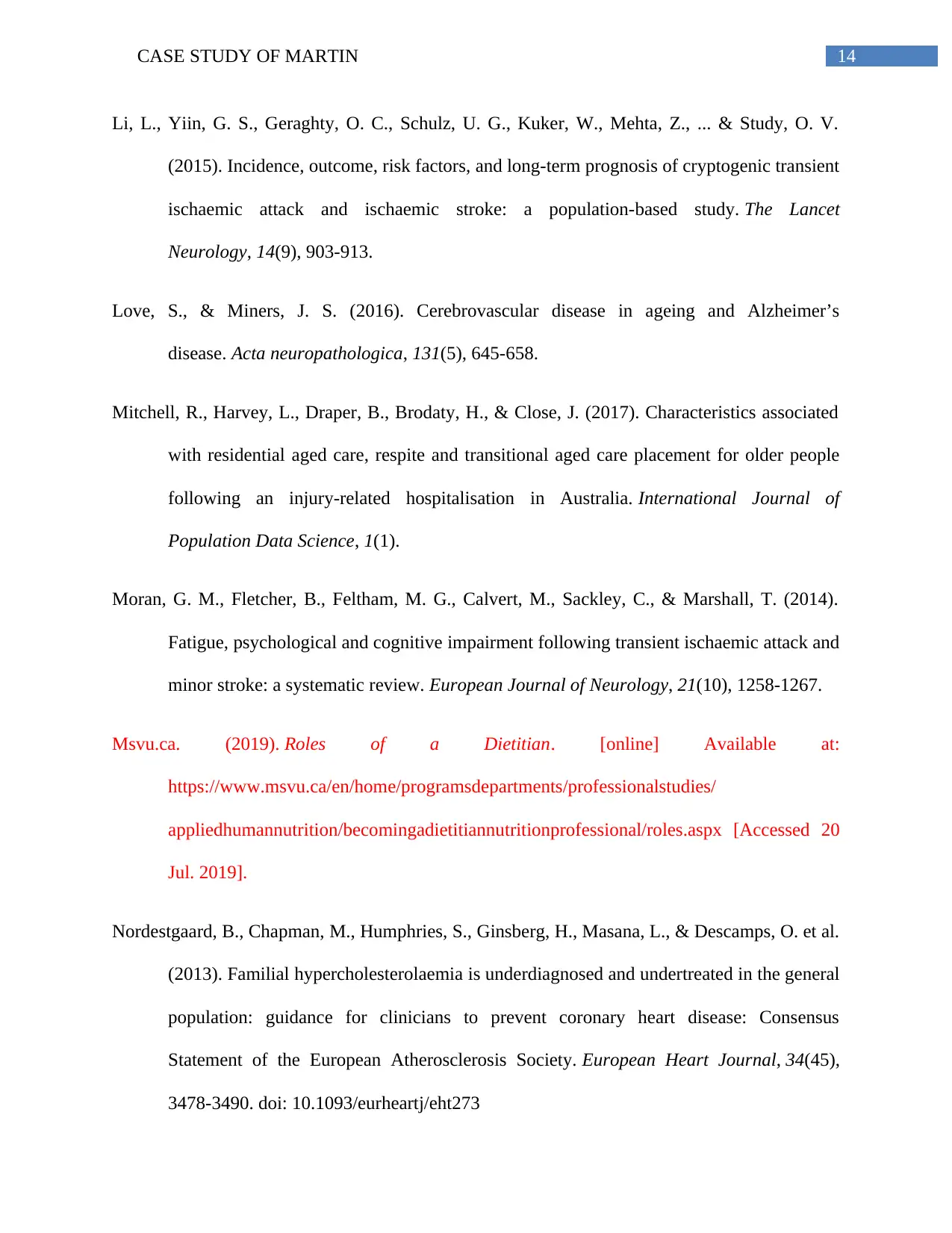
14CASE STUDY OF MARTIN
Li, L., Yiin, G. S., Geraghty, O. C., Schulz, U. G., Kuker, W., Mehta, Z., ... & Study, O. V.
(2015). Incidence, outcome, risk factors, and long-term prognosis of cryptogenic transient
ischaemic attack and ischaemic stroke: a population-based study. The Lancet
Neurology, 14(9), 903-913.
Love, S., & Miners, J. S. (2016). Cerebrovascular disease in ageing and Alzheimer’s
disease. Acta neuropathologica, 131(5), 645-658.
Mitchell, R., Harvey, L., Draper, B., Brodaty, H., & Close, J. (2017). Characteristics associated
with residential aged care, respite and transitional aged care placement for older people
following an injury-related hospitalisation in Australia. International Journal of
Population Data Science, 1(1).
Moran, G. M., Fletcher, B., Feltham, M. G., Calvert, M., Sackley, C., & Marshall, T. (2014).
Fatigue, psychological and cognitive impairment following transient ischaemic attack and
minor stroke: a systematic review. European Journal of Neurology, 21(10), 1258-1267.
Msvu.ca. (2019). Roles of a Dietitian. [online] Available at:
https://www.msvu.ca/en/home/programsdepartments/professionalstudies/
appliedhumannutrition/becomingadietitiannutritionprofessional/roles.aspx [Accessed 20
Jul. 2019].
Nordestgaard, B., Chapman, M., Humphries, S., Ginsberg, H., Masana, L., & Descamps, O. et al.
(2013). Familial hypercholesterolaemia is underdiagnosed and undertreated in the general
population: guidance for clinicians to prevent coronary heart disease: Consensus
Statement of the European Atherosclerosis Society. European Heart Journal, 34(45),
3478-3490. doi: 10.1093/eurheartj/eht273
Li, L., Yiin, G. S., Geraghty, O. C., Schulz, U. G., Kuker, W., Mehta, Z., ... & Study, O. V.
(2015). Incidence, outcome, risk factors, and long-term prognosis of cryptogenic transient
ischaemic attack and ischaemic stroke: a population-based study. The Lancet
Neurology, 14(9), 903-913.
Love, S., & Miners, J. S. (2016). Cerebrovascular disease in ageing and Alzheimer’s
disease. Acta neuropathologica, 131(5), 645-658.
Mitchell, R., Harvey, L., Draper, B., Brodaty, H., & Close, J. (2017). Characteristics associated
with residential aged care, respite and transitional aged care placement for older people
following an injury-related hospitalisation in Australia. International Journal of
Population Data Science, 1(1).
Moran, G. M., Fletcher, B., Feltham, M. G., Calvert, M., Sackley, C., & Marshall, T. (2014).
Fatigue, psychological and cognitive impairment following transient ischaemic attack and
minor stroke: a systematic review. European Journal of Neurology, 21(10), 1258-1267.
Msvu.ca. (2019). Roles of a Dietitian. [online] Available at:
https://www.msvu.ca/en/home/programsdepartments/professionalstudies/
appliedhumannutrition/becomingadietitiannutritionprofessional/roles.aspx [Accessed 20
Jul. 2019].
Nordestgaard, B., Chapman, M., Humphries, S., Ginsberg, H., Masana, L., & Descamps, O. et al.
(2013). Familial hypercholesterolaemia is underdiagnosed and undertreated in the general
population: guidance for clinicians to prevent coronary heart disease: Consensus
Statement of the European Atherosclerosis Society. European Heart Journal, 34(45),
3478-3490. doi: 10.1093/eurheartj/eht273
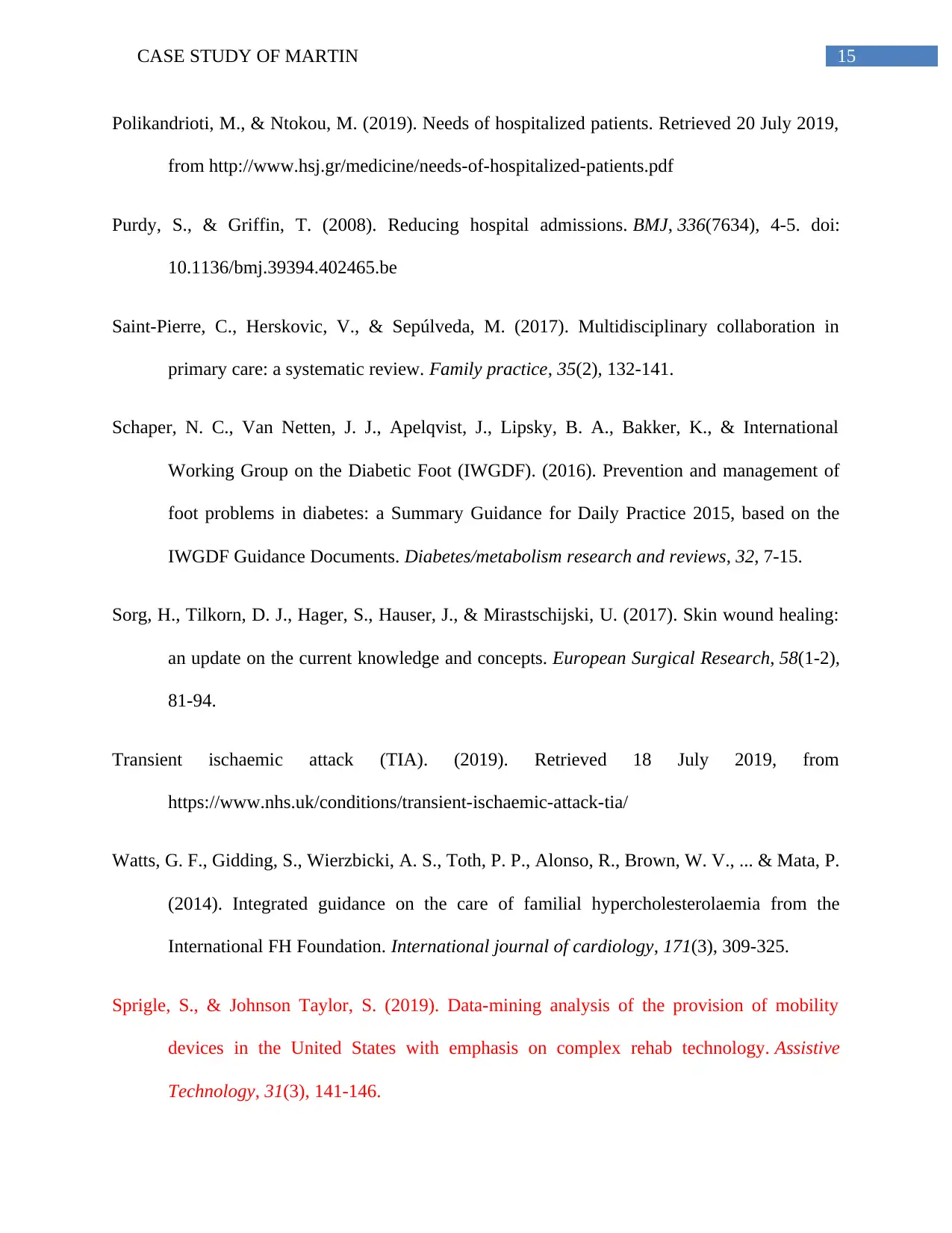
15CASE STUDY OF MARTIN
Polikandrioti, M., & Ntokou, M. (2019). Needs of hospitalized patients. Retrieved 20 July 2019,
from http://www.hsj.gr/medicine/needs-of-hospitalized-patients.pdf
Purdy, S., & Griffin, T. (2008). Reducing hospital admissions. BMJ, 336(7634), 4-5. doi:
10.1136/bmj.39394.402465.be
Saint-Pierre, C., Herskovic, V., & Sepúlveda, M. (2017). Multidisciplinary collaboration in
primary care: a systematic review. Family practice, 35(2), 132-141.
Schaper, N. C., Van Netten, J. J., Apelqvist, J., Lipsky, B. A., Bakker, K., & International
Working Group on the Diabetic Foot (IWGDF). (2016). Prevention and management of
foot problems in diabetes: a Summary Guidance for Daily Practice 2015, based on the
IWGDF Guidance Documents. Diabetes/metabolism research and reviews, 32, 7-15.
Sorg, H., Tilkorn, D. J., Hager, S., Hauser, J., & Mirastschijski, U. (2017). Skin wound healing:
an update on the current knowledge and concepts. European Surgical Research, 58(1-2),
81-94.
Transient ischaemic attack (TIA). (2019). Retrieved 18 July 2019, from
https://www.nhs.uk/conditions/transient-ischaemic-attack-tia/
Watts, G. F., Gidding, S., Wierzbicki, A. S., Toth, P. P., Alonso, R., Brown, W. V., ... & Mata, P.
(2014). Integrated guidance on the care of familial hypercholesterolaemia from the
International FH Foundation. International journal of cardiology, 171(3), 309-325.
Sprigle, S., & Johnson Taylor, S. (2019). Data-mining analysis of the provision of mobility
devices in the United States with emphasis on complex rehab technology. Assistive
Technology, 31(3), 141-146.
Polikandrioti, M., & Ntokou, M. (2019). Needs of hospitalized patients. Retrieved 20 July 2019,
from http://www.hsj.gr/medicine/needs-of-hospitalized-patients.pdf
Purdy, S., & Griffin, T. (2008). Reducing hospital admissions. BMJ, 336(7634), 4-5. doi:
10.1136/bmj.39394.402465.be
Saint-Pierre, C., Herskovic, V., & Sepúlveda, M. (2017). Multidisciplinary collaboration in
primary care: a systematic review. Family practice, 35(2), 132-141.
Schaper, N. C., Van Netten, J. J., Apelqvist, J., Lipsky, B. A., Bakker, K., & International
Working Group on the Diabetic Foot (IWGDF). (2016). Prevention and management of
foot problems in diabetes: a Summary Guidance for Daily Practice 2015, based on the
IWGDF Guidance Documents. Diabetes/metabolism research and reviews, 32, 7-15.
Sorg, H., Tilkorn, D. J., Hager, S., Hauser, J., & Mirastschijski, U. (2017). Skin wound healing:
an update on the current knowledge and concepts. European Surgical Research, 58(1-2),
81-94.
Transient ischaemic attack (TIA). (2019). Retrieved 18 July 2019, from
https://www.nhs.uk/conditions/transient-ischaemic-attack-tia/
Watts, G. F., Gidding, S., Wierzbicki, A. S., Toth, P. P., Alonso, R., Brown, W. V., ... & Mata, P.
(2014). Integrated guidance on the care of familial hypercholesterolaemia from the
International FH Foundation. International journal of cardiology, 171(3), 309-325.
Sprigle, S., & Johnson Taylor, S. (2019). Data-mining analysis of the provision of mobility
devices in the United States with emphasis on complex rehab technology. Assistive
Technology, 31(3), 141-146.
1 out of 16
Related Documents
Your All-in-One AI-Powered Toolkit for Academic Success.
+13062052269
info@desklib.com
Available 24*7 on WhatsApp / Email
![[object Object]](/_next/static/media/star-bottom.7253800d.svg)
Unlock your academic potential
© 2024 | Zucol Services PVT LTD | All rights reserved.





